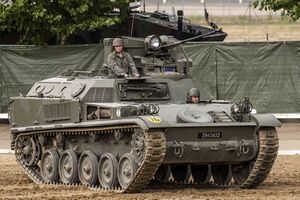Bataís APC
| 1962-2 Model APC | |
|---|---|
 A 1962-5 Variant Model vehicle. | |
| Type | Armored Personnel Carrier |
| Place of origin | Faneria |
| Service history | |
| In service | 1963–present - Faneria, Maloka (36), Mutsutori (4), GaelWind Popular Front (2-6) |
| Wars | Archipelago War, Vandarch Canal Crisis, Malokan Month's War |
| Production history | |
| Designed | 1958-1961 |
| Unit cost | x million Thaler/unit |
| Produced | 1963-2004 |
| Variants | 1962-1 (not produced), 1962-2 (1257), 1962-3 (1802), 1962-4 (4423), 1962-5 (3200) |
| Specifications | |
| Mass | 15.1 - 15.6 tons |
| Length | x ft (22.6 without gun) (x with 1962-4 variant) |
| Width | x ft (x with 1962-4 variant) |
| Height | x ft (x with 1962-4 variant) |
| Crew | 3 (Commander, gunner, driver) |
Main armament | 1982-1 Model 4.75" Rifled Cannon (38 rounds, one chambered, 30 HVAP rounds in auto-loader, 7 HE rounds in hull storage) |
Secondary armament |
|
| Engine | 250-400 hp depending on variant |
| Power/weight | 16.5 hp/t (later 25.6 hp/t) |
Operational range | 225 miles (later 250) |
| Maximum speed | 36 mph on road, 30 mph open offroad (1962-2/3), 55 mph on road, 50 mph open offroad (1962-4) |
Colloquially 'Bataís' (for Cillac Bataís, Taoiseac 1945-1950)
Design
Suppliers
The parts for the 1962-2 were manufactured primarily within Faneria, with the major companies involved being:
Madrat Motor Design: Produced the enginesn of all variants and ventilation systems.
Ginearált Lionsag (General Lensing): Produced ports and other glassware parts.
Luthair National Munitions: Produced the ammunition.
Ginearált Dealbhadh Coimpiutair (General Computer Design): Produced the electronics added in the 1962-4 and -5 variants.
Teilgcheárta de Làmhachas Nàiseanta Fhainn (Fhainnin National Heavy Arms Foundry): Produced the machine gun and later cannon.
Werthwr Stàilinobaer: Produced the basic armor plates and frame, and later the blowout panels and later compartmentalization pieces.
Teilgcheárta de Armachd Nàiseanta Fhainn (Fhainnin National Armor Plant): Produced additional armor components, interior frame components, later turrets, and assembled the platforms.
Performance
The original variant of the vehicle was considered underpowered, even for its time, but budget issues and the general weak stance of the military socially made spending on upgrades and refits difficult. Later variants brought the Bataís to par with competing APCs in terms of speed and horsepower, however. The original armament was gradually replaced with a turret ring allowing for a .8" cannon to be installed, with the machine gun being optional as a commander's pintle weapon.
Later variants of the Bataís became respected additions to the military's arsenal (in sharp contrast to the -2 Model), and in combat proved effective at their role as a dedicated transport and light support vehicle; still, the design was never meant to incorporate many of the systems later added, which made maintenance increasingly more complex.
Foreign Purchases/Licensing and Use
Successors
The Bataís was replaced in its role as an APC by the Capall 2002-1 (eng. Horse/Steed) in 2004, but remains in service abroad and as a 'filler' transport vehicle for rear-line support staff. The Capall takes many of its design notes from the Bataís but is designed with the many later technological advances retrofitted into the 1962-2 in mind.